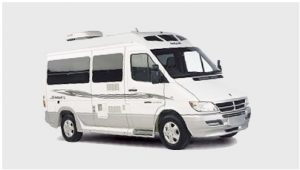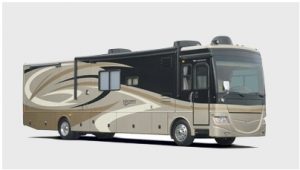Motorized RVs are divided into three classes which are fairly clear cut between the three classes.
Click on one of the RV Types below to learn more about that type:
Drivable Motorized Motorhome RV Types
 Class C Motorhome Information Page
Class C Motorhome Information Page Class C RVs are built on a standardized truck or pickup frame. You can tell because they look like a pickup front end, like a F350 or F450, yet have the RV backend.
Class C Motorhomes are less expensive than the Class A, yet can tow cars.
Typically a Class C is gas powered, but that isn't 100% true all the time.
 Class B Motorhome Information Page
Class B Motorhome Information Page
Class B RVs are built around the idea of a conversion van. They take things like a GMC, Ford, or Mercedes van and finish it out as an RV.
Class B motorhome are touring beasts and I think most people use the Class B as their main vehicle for tooling around as well - that means you don't need to tow a car. If you are an outdoorsy person, I would think these would be wonderful.
 Class A Motorhomes
Class A Motorhomes The first and most famous type of RV is the Class A RV. Class A RVs are built on a custom chassis or a bus chassis. The driver area is built seamlessly into the rest of the RV.
Three options for towing a “get around” vehicle (Toad) behind your motorized RV
Almost 9 million people own RVs, according to the Recreational Vehicle Industry Association, and they’re a great way to take you and the family across long distances in comfort.
But it’s not exactly easy to go to the grocery store or check out some local attractions in an RV. One solution? Tow your car behind you. You may need special equipment to do it safely and under warranty, so read on to learn the best way to go about it.
Before You Tow
Go through your car’s owner’s manual and look for information on vehicle towing. If you don’t have information on towing, you are likely not covered under warranty for flat towing, but trailer or dolly towing is acceptable.
Flat Towed (Toad)
The flat-towing method doesn’t require a trailer to put your car on, making it a good choice for RVers who don’t want to maintain large additional equipment. The easiest cars to flat tow are manual transmission cars with rear-wheel or four-wheel drive, according to Edmunds. Aftermarket equipment is used for vehicles that cannot be flat towed as is, circulating transmission fluid to keep the engine and other systems working properly.
In addition to the tow bar, you’ll need to attach a baseplate to your vehicle and a hitch receiver to connect everything together. Double check your car’s weight against your RV’s tow bar, as different tow bars are designed for different capacities. For example, the Roadmaster’s Sterling All-Terrain tow bar is designed for 6,000-pound vehicles, while the Aventa LX is compatible with 10,000-pound vehicles.
Flat towing puts wear and tear on your car’s tires, so check that the tread isn’t worn and the rubber is in good condition. You don’t want to end up at your destination with a flat, so consider buying a new set of General tires before you leave. Do a fluids and oil check, too.
Dollies
Sometimes it’s difficult to find the right aftermarket parts for automatic vehicles, especially if you have an older, less popular car. A tow dolly lifts the front wheels of your car off of the ground, leaving only the rear wheels doing the work.
You don’t need aftermarket parts or any special equipment to use a tow dolly with a front wheel drive automatic, which gets you around the necessity of figuring out a way to circulate transmission fluid.
Trailer
Trailers take all four of your vehicle’s wheels off the ground, so it doesn’t matter whether it’s front, rear or all-wheel drive. As long as it fits on the trailer, it can come with you without adding wear and tear on the vehicle.
You avoid the hassle of searching for aftermarket parts or dealing with tow bars, but that’s balanced out by buying and maintaining a trailer throughout the year. It’s a convenient option for compatibility, but it may not be the best option when you’re limited on space.
The downside is that you still have to worry about towing capacity, stopping power (brakes), and the overall length of the entire get-up.
Shop at the stores you ALREADY shop at! Nothing new (except savings)
Click here for $10 on your first shopping trip by trying Rakuten (used to be eBates)
Risk Free!

Leave a Reply